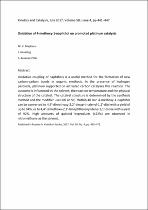JavaScript is disabled for your browser. Some features of this site may not work without it.
- ResearchSpace
- →
- Research Publications/Outputs
- →
- Journal Articles
- →
- View Item
| dc.contributor.author |
Maphoru, MV

|
|
| dc.contributor.author |
Heveling, J

|
|
| dc.contributor.author |
Kesavan Pillai, Sreejarani

|
|
| dc.date.accessioned | 2018-04-11T09:17:14Z | |
| dc.date.available | 2018-04-11T09:17:14Z | |
| dc.date.issued | 2017-07 | |
| dc.identifier.citation | Maphoru, M.V., Heveling, J. and Kesavan Pillai, S. 2017. Oxidation of 4-methoxy-1-naphthol on promoted platinum catalysts. Kinetics and Catalysis, vol. 58(4): 441-447 | en_US |
| dc.identifier.issn | 0023-1584 | |
| dc.identifier.issn | 1608-3210 | |
| dc.identifier.uri | https://link.springer.com/article/10.1134/S0023158417040103 | |
| dc.identifier.uri | http://hdl.handle.net/10204/10175 | |
| dc.description | Due to copyright restrictions, the attached PDF file only contains the abstract of the full text item. For access to the full text item, please consult the publisher's website. This article is also published in Russian in Kinetika i Kataliz, 2017, Vol. 58, No. 4, pp. 465-472 | en_US |
| dc.description.abstract | Oxidative coupling of naphthols is a useful method for the formation of new carbon-carbon bonds in organic synthesis. In the presence of hydrogen peroxide, platinum supported on activated carbon catalyses this reaction. The outcome is influenced by the solvent, the reaction temperature and the physical structure of the catalyst. The catalyst structure is determined by the synthesis method and the modifier used (Bi or Sb). Within 40 min 4-methoxy-1-naphthol can be converted to 4,4'-dimethoxy-2,2'-binaphthalenyl-1,1'-diol with a yield of up to 94%, or to 4,4'-dimethoxy-2,2'-binaphthalenylidene-1,1'-dione with a yield of 92%. High amounts of quinoid byproducts (=22%) are observed in nitromethane as the solvent. | en_US |
| dc.language.iso | en | en_US |
| dc.publisher | Pleiades Publishing, Ltd, also Springer | en_US |
| dc.relation.ispartofseries | Worklist;20377 | |
| dc.subject | 1-naphthol | en_US |
| dc.subject | Oxidative coupling | en_US |
| dc.subject | Platinum | en_US |
| dc.subject | Promoter | en_US |
| dc.subject | Selectivity | en_US |
| dc.subject | Solvent effect | en_US |
| dc.title | Oxidation of 4-methoxy-1-naphthol on promoted platinum catalysts | en_US |
| dc.type | Article | en_US |
| dc.identifier.apacitation | Maphoru, M., Heveling, J., & Kesavan Pillai, S. (2017). Oxidation of 4-methoxy-1-naphthol on promoted platinum catalysts. http://hdl.handle.net/10204/10175 | en_ZA |
| dc.identifier.chicagocitation | Maphoru, MV, J Heveling, and Sreejarani Kesavan Pillai "Oxidation of 4-methoxy-1-naphthol on promoted platinum catalysts." (2017) http://hdl.handle.net/10204/10175 | en_ZA |
| dc.identifier.vancouvercitation | Maphoru M, Heveling J, Kesavan Pillai S. Oxidation of 4-methoxy-1-naphthol on promoted platinum catalysts. 2017; http://hdl.handle.net/10204/10175. | en_ZA |
| dc.identifier.ris | TY - Article AU - Maphoru, MV AU - Heveling, J AU - Kesavan Pillai, Sreejarani AB - Oxidative coupling of naphthols is a useful method for the formation of new carbon-carbon bonds in organic synthesis. In the presence of hydrogen peroxide, platinum supported on activated carbon catalyses this reaction. The outcome is influenced by the solvent, the reaction temperature and the physical structure of the catalyst. The catalyst structure is determined by the synthesis method and the modifier used (Bi or Sb). Within 40 min 4-methoxy-1-naphthol can be converted to 4,4'-dimethoxy-2,2'-binaphthalenyl-1,1'-diol with a yield of up to 94%, or to 4,4'-dimethoxy-2,2'-binaphthalenylidene-1,1'-dione with a yield of 92%. High amounts of quinoid byproducts (=22%) are observed in nitromethane as the solvent. DA - 2017-07 DB - ResearchSpace DP - CSIR KW - 1-naphthol KW - Oxidative coupling KW - Platinum KW - Promoter KW - Selectivity KW - Solvent effect LK - https://researchspace.csir.co.za PY - 2017 SM - 0023-1584 SM - 1608-3210 T1 - Oxidation of 4-methoxy-1-naphthol on promoted platinum catalysts TI - Oxidation of 4-methoxy-1-naphthol on promoted platinum catalysts UR - http://hdl.handle.net/10204/10175 ER - | en_ZA |






